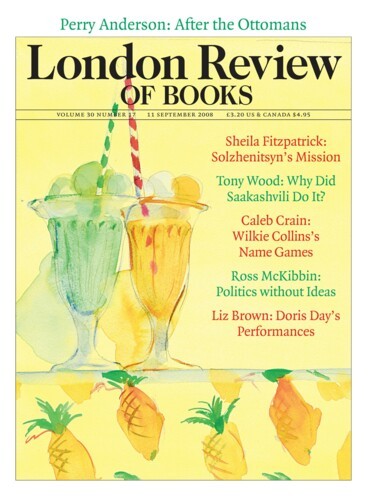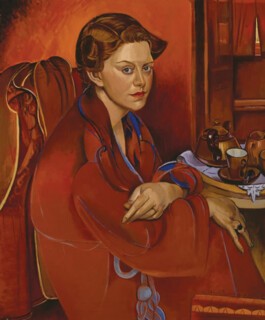Wyndham Lewis’s Modernism refuses a provincial label. His intellectual toughness and taste for self-promotion and polemic were foreign to the amateurishness that, he believed, vitiated Bloomsbury’s insular Post-Impressionism. Vorticism, the movement he set up with Pound and others around 1913 after a break with Roger Fry, would probably have had a short life even if the war had not intervened. Lewis was not a team player; looking back he said: ‘Vorticism, in fact, was what I, personally, did, and said, at a certain period.’ Other surviving Vorticists were, with reason, displeased. It is hard to see how any movement could have been sustained by someone so liable to bite the hand that fed him. His novel The Apes of God doesn’t just mock the artistic competition, but also some of those who had given him money when he sorely needed it.
All this is relevant to the exhibition Wyndham Lewis Portraits (until 19 October), but negatively. The pictures are not the caricatures that his acerbic relationships and the things he said about some of the subjects might lead one to expect. Hard lines and simplified volumes do preclude nuances of expression, but the simplification that a cartoonist would use to exaggerate salient features results instead in iconic images: representations of what the person is understood to be, of their status and reputation, rather than of how they looked at a particular time. In the catalogue Paul Edwards compares one of Lewis’s self-portraits to Droeshout’s engraving of Shakespeare. The juxtaposition is telling. In both in the engraving and Lewis’s portraits cheeks, nose, chin and eyelids read as sculpted volumes rather than soft, mobile flesh. You wouldn’t have got much help if you were trying to imagine what Shakespeare or Lewis might have looked like had they walked into the room. On the other hand, the engraving has only to appear on the page for all that attaches to Shakespeare’s name to be called up, while the painting is less effective only because it is in the nature of an icon that the viewer must have ideas to attach to it, and Lewis is not so famous. His portraits of Eliot and Pound wouldn’t be icons if we knew nothing about the sitters. Even unforgettable photographs like the one Richard Avedon took of Pound in the late 1950s are attached to one time and place. The Lewis portraits represent the man rather than the man at a given moment. Eliot, hair neatly parted, three-piece grey suit, handkerchief in breast pocket, is the conservative publisher. The expression on his face, fixed and solemn, offers the poet and thinker. It is a representation that has more in common with the head of Alexander the Great on a coin, with Queen Elizabeth in any number of portraits, or Queen Victoria in the statues that stand on plinths in squares and parks all over her erstwhile empire than with a portrait like Sargent’s of Henry James, which encourages you to look for evidence of personality in physiognomy. Iconic portraits by contrast are suitable memorials of reputation. That is what the boardroom and the college committee are after, even if they very rarely get it.
The simplified modelling that went with the breakdown of objects into geometrically describable elements obscures personality, and Modernist games with appearance typically distorted appearance. But despite his attachment to Cubism and Futurism, Lewis’s portraits do not require another reference – a photograph, say – for interpretation. In that respect they are like Picasso’s portrait of Gertrude Stein (another iconic image) but unlike Picasso’s Cubist portrait of Vollard, which, like Cubist still lifes of jugs, bottles and guitars, takes much of its force from the reconstruction one has to make of a fragmented original.
Although there are among the pictures in the exhibition a number of powerful images, they are not, by strict criteria, great portraits. The publicity for the exhibition makes much of the telegram Walter Sickert sent Lewis in 1932. The pencil portrait of Rebecca West, Sickert said, proved Lewis to be ‘the greatest portraitist of this or any other time’. Sickert would probably not have committed his telegraphic praise of the portraits to print. On the other hand Lewis’s rhythmic curves and hard lines would have been consonant with Sickert’s idea that drawing is always a process whereby form is abstracted from the complexity of the visual world. Lewis was never a wholehearted abstractionist – he explained why late in his life in The Demon of Progress in the Arts. So while the portraits contain a few passages of pure pattern-making, they are rare. In the 1923-25 Tate portrait of Edith Sitwell, the face is no more simplified than faces are in the Byzantine icons of the Virgin that it strongly resembles. The chair Sitwell sits in, a shelf of books and a globe are firmly geometrical but still perfectly recognisable. Only her fingers are caught up in an area of abstraction: bright red, yellow and green blocks that may not be fingers at all, but something she is wearing. In the Eliot portrait of 1938, two hangings on the wall behind him give a taste of Lewis in a less objective mood. In 1938, the Royal Academy refused to hang the picture. They had spotted phallic references in the hangings.
Wyndham Lewis’s paint is thin. Many modern painters in the first half of the 20th century painted thin and neat. It could have been a reaction against the big gestures of the swagger portrait and the thick dabs of the Impressionists. It might even have had something to do with the cost of paint. Whatever the cause, the impression it leaves is that the Vorticists, like the Surrealists, were more concerned with what the picture showed, with imagery and narrative, than with the picture as object. But thin paint goes well with drawn lines, and the best of Lewis’s portraits are a pleasure to read, touch by touch. In that – in his handwriting, as it were – an English way of drawing with paint makes its appearance.
It is impossible to consider Lewis as a painter without taking into account the fact that he was also a writer. English painters have written more than most. Some, like Blake, David Jones, Mervyn Peake and Michael Ayrton (who did a portrait of Lewis and dust jackets for his late novels), have created literary and visual worlds that overlap. Lewis, despite being a novelist, was more like Sickert or Hogarth, who used words to fight critical battles. His paintings and drawings of literary Modernists adumbrate a common future for painting and writing. It never happened, but the portraits record a time when one person at least believed it was possible.
Send Letters To:
The Editor
London Review of Books,
28 Little Russell Street
London, WC1A 2HN
letters@lrb.co.uk
Please include name, address, and a telephone number.


